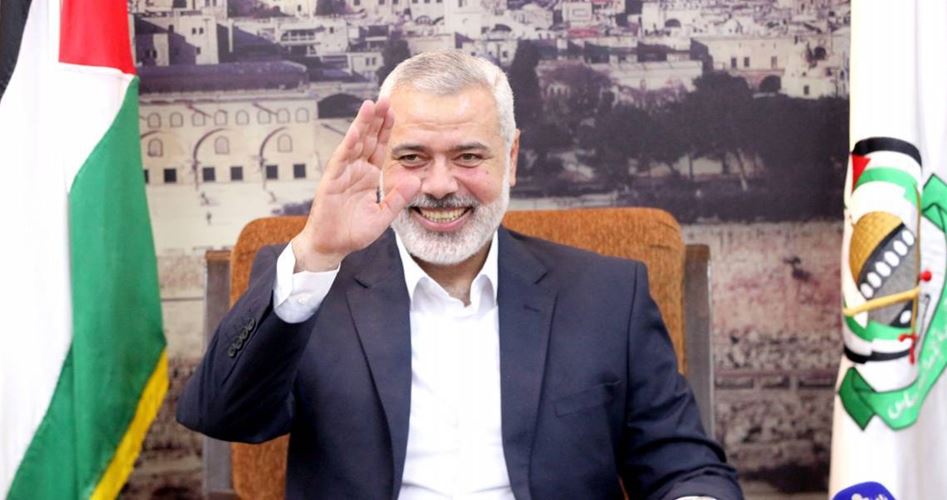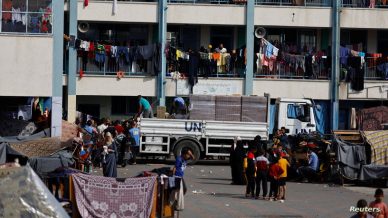‘Take all positions take all jobs and leave our homeland for us.’ These words resonate in the ears of thousands of Palestinians to mark a path that Ismail Haneyya has embarked on for 30 years of his membership at the Hamas Movement since he was a young boy until he became a leader of the Movement when he was elected as the chairman of its political bureau succeeding Khaled Mishaal.
In a free and democratic elections conducted at the councils and frameworks of the Islamic Resistance Movement Hamas Haneyya was elected as the head of Hamas’s political bureau replacing Khaled Mishaal who has held this post since 1996.
Haneyya started his career in Hamas as early as his academic studies by being involved in students’ activities to follow the same approach for over 30 years the age of Hamas in which he held several positions to be known for his ‘positions’ and ‘consensus’.
Haneyya known for his moderate personality was able to maintain good national relations by embracing all Palestinians in the Gaza Strip despite the different positions and ideologies without affecting the constants he has always emphasized in relation to the occupation and strengthening the resistance.
Haneyya maintained a popular presence in Hamas and in terms of internal Palestinian relations especially among the people of Shati refugee camp who had long lived with him during his presidency of the Islamic Society and its sports club as well as at the external level where he showed a great success establishing many relations with many countries outside Palestine which became now the most important supporters of the Palestinian cause.
In spite of the many positions he held Haneyya kept living in Shati camp where he received many prominent figures and has been living there for decades with his family. He continued to lead the worshipers in mosques even after he assumed the presidency of the Palestinian government.
Ismail Haneyya
Ismail Abdel-Salam Haneyya 54 was born in Shati refugee camp on May 23 1963 after his parents ended up refugees from the city of Askalan in occupied Palestine after the Palestinian Nakba in 1948. He completed his elementary and preparatory education at UNRWA schools in the refugee camp.
Haneyya received his high school degree from the al-Azhar Religious Institute in Gaza. This period was one of the most important periods that contributed to the crystallization of his personality and Islamic orientation. He got married in 1980 and joined the Department of Arabic Language at the Faculty of Education at the Islamic University of Gaza obtaining a degree in Arabic Literature.
During his university studies he was a prominent figure participating in activities of the ‘Islamic Bloc’ the student bloc of Hamas in addition to his interest in sports activities. He also served as a member of the Students Council of the Islamic University in Gaza between 1983 and 1984.
Arrest and deportation
In 1987 after the outbreak of the first Palestinian uprising the Israeli occupation authorities arrested Haneyya for the first time where he was held in prison for 18 days. He was arrested for the second time in 1988 for six months where he was famous during the first intifada as a young Hamas leader and an outspoken speaker.
Haneyya was arrested for the third time in 1989 on charges of belonging to the Islamic Resistance Movement (Hamas) and leading the security apparatus of the Hamas Movement. He served three years in detention.
Following his arrest Haneyya was deported on 17 December 1992 along with 415 Palestinians to Marj al-Zuhour area in southern Lebanon but he returned to the Gaza Strip after spending a year in exile.
In 1997 following the release of the founder of the Movement Ahmed Yassin from the Israeli occupation jails Haneyya served as the director of his office and strengthened his relationship with the Sheikh.
Haneyya held several positions at the Islamic University of Gaza before becoming a member of its board of trustees in 1997. He was a member of the Higher Committee for Dialogue and a representative of Hamas in the Higher Follow-up Committee of the National and Islamic Factions during the second uprising.
The Israeli occupation forces tried to assassinate Haneyya when he was with Sheikh Ahmed Yassin on September 6 2003 after an Israeli raid targeted them at the house of Hamas leader Marwan Abu Ras in Al-Daraj district east of Gaza City. They survived and sustained minor injuries.
During one of the Israeli wars on Gaza the Israeli warplanes targeted his house in Gaza in an attempt to assassinate him.
In 2006 Haneyya headed the Change and Reform list which won the majority of the seats in the Palestinian Legislative Council in early January and became the head of the Hamas-led Palestinian government in February 2006 where attempts to undermine his rule from both internal and external actors began.
Haneyya has always been keen to open the door for national reconciliation with the Fatah movement and gave up his Prime Minister position as part of a framework of a comprehensive reconciliation which includes forming a national unity government.
Haneyya signed the Shati reconciliation agreement at his house in 2014 which ended seven years of political division. After the agreement a national unity government was formed instead of the governments of Gaza and the West Bank which was headed by Rami al-Hamdallah.















